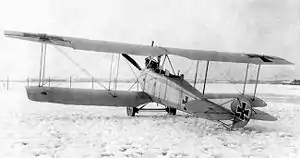Aviatik C.I
The Aviatik C.I was an observation aircraft which came into service during World War I in April 1915. It was a development of the Aviatik B.I and B.II models, being one of first aircraft of the new German C class of armed biplanes. In the C.I the observer sat in front of the pilot, with a machine-gun clipped on a sliding mounting fitted on a rail at either side of the cockpit.[1] It gave the crew the means to attack enemy aircraft.[2] The positions of the pilot and observer were reversed in last series of 50, ordered in 1917 solely for trainer purpose.[3] There was only one aircraft built of refined C.Ia version in May 1916, with armament still in a forward cab, serving as a prototype for C.III.[3] Later models of the plane included the Aviatik C.II and the C.III, which had more powerful engines. The C.III was produced in large numbers.
| C.I | |
|---|---|
 | |
| Aviatik C.I trainer (late series) | |
| Role | Reconnaissance aircraft |
| Manufacturer | Aviatik |
| First flight | 1915 |
| Introduction | 1915 |
| Retired | 1917 |
548 Aviatik C.I were built in total: 402 by Aviatik (including 51 trainers and 1 C.Ia) and 146 by Hannover.[4]
Variants
- C.I
- Primary model
- C.I(Han)
- Primary model licence-built by Hannover, initially designated Hannover C.I
- C.I trainer
- Last series of 50 plus a prototype manufactured in 1917, with a machine gun in rear cab.[3]
- C.Ia
- Prototype for C.III, flown in May–June 1916.[3]
- C.II
- This model was powered by a 149 kW (200 hp) Benz Bz.IV engine. it was not produced in quantity.[5]
- C.III
- The C.III was a 1916 refinement which was operated until 1917.[5]
Operators
- Royal Yugoslav Air Force - Postwar
Specifications
Data from German Aircraft of the First World War[6]
General characteristics
- Crew: 2
- Length: 7.925 m (26 ft 0 in)
- Wingspan: 12.5 m (41 ft 0 in)
- Height: 2.95 m (9 ft 8 in)
- Wing area: 43 m2 (460 sq ft)
- Empty weight: 750 kg (1,653 lb)
- Gross weight: 1,340 kg (2,954 lb)
- Powerplant: 1 × Mercedes D.III 6-cylinder water-cooled in-line piston engine, 119 kW (160 hp)
- Propellers: 2-bladed fixed-pitch propeller
Performance
- Maximum speed: 142 km/h (88 mph, 77 kn)
- Endurance: 3 hours
- Service ceiling: 3,500 m (11,500 ft)
- Time to altitude: 1,000 m (3,281 ft) in 12 minutes
- Wing loading: 31.2 kg/m2 (6.4 lb/sq ft)
- Power/mass: 0.089 kW/kg (0.054 hp/lb)
Armament
- Guns: 1x Parabellum MG14 mounted on cockpit side rails
Notes
- Gray, Thetford (1970), p. 59-63
- van Wyngarden, G. Early German Aces, p.6
- Grosz, Peter M. Aviatik C.I. Berkhamsted: Albatros Productions, 1997, Windsock Datafile no.63. ISBN 0-948414-95-2. p.5-6
- Grosz, Peter M. Aviatik C.I. Berkhamsted: Albatros Productions, 1997, Windsock Datafile no.63. ISBN 0-948414-95-2. p.5-6, 32
- Janes, p.88
- Thetford 1962, pp.59–63.
References
- Gray, Peter & Thetford, Owen (1987) [1970]. German Aircraft of the First World War (2nd ed.). London: Putnam. ISBN 0-85177-809-7.
- Herris, Jack (2023). Aviatik Aircraft of WWI: A Centennial Perspective on Great War Airplanes. Great War Aviation Centennial Series. Vol. 10 (2nd ed.). n.p.: Aeronaut Books. ISBN 978-1-953201-59-1.
- Klaauw, Bart van der (March–April 1999). "Unexpected Windfalls: Accidentally or Deliberately, More than 100 Aircraft 'arrived' in Dutch Territory During the Great War". Air Enthusiast (80): 54–59. ISSN 0143-5450.
- van Wyngarden, G. Early German Aces of World War 1. Oxford: Osprey Publishing, 2006. ISBN 1-84176-997-5
- Taylor, Michael J H. Jane's Encyclopedia of Aviation. Portland House, 1989. ISBN 0-517-69186-8